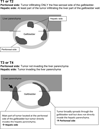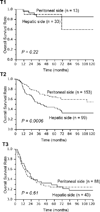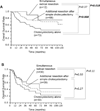Tumor location is a strong predictor of tumor progression and survival in T2 gallbladder cancer: an international multicenter study
- PMID: 24854451
- PMCID: PMC4800978
- DOI: 10.1097/SLA.0000000000000728
Tumor location is a strong predictor of tumor progression and survival in T2 gallbladder cancer: an international multicenter study
Abstract
Objective: To determine the prognostic impact of tumor location in gallbladder cancer.
Background: Depth of tumor is a strong predictor of survival after curative resection of gallbladder cancer. However, the gallbladder has a unique anatomical relationship with the liver, and the clinical significance of tumor location remains unclear.
Methods: For 437 patients with gallbladder cancer who underwent resection at 4 international institutions, clinicopathologic characteristics and their association with survival were analyzed. Tumor location was defined as "hepatic side" or "peritoneal side," and the prognostic significance of tumor location was evaluated.
Results: Among the 252 patients with T2 disease, patients with tumors on the hepatic side (T2h, n = 99) had higher rates of vascular invasion, neural invasion, and nodal metastasis than patients with tumors on the peritoneal side (T2p, n = 153) (51% vs 19%, 33% vs 8%, and 40% vs 17%, respectively; P < 0.01 for all). After a median follow-up of 58.9 months, 3-year and 5-year survival rates were 52.1% and 42.6%, respectively, for T2h tumors and 73.7% and 64.7%, respectively, for T2p tumors (P = 0.0006). No such differences were observed in T1 or T3 tumors. Multivariate analysis confirmed the independent association of hepatic-side location with survival in T2 tumors (hazard ratio, 2.7; 95% confidence interval, 1.7-4.2; P < 0.001). This subclassification of T2 tumors predicted recurrence in the liver (23% vs 3%; P = 0.003) and distant lymph nodes (16% vs 3%; P = 0.019) even after radical resection.
Conclusions: After curative resection of T2 gallbladder cancer, tumor location predicts the pattern of recurrence and survival.
Conflict of interest statement
Figures






References
-
- American Cancer Society. Cancer Facts and Figures 2013. Atlanta, GA: American Cancer Society; 2013.
-
- Miyakawa S, Ishihara S, Horiguchi A, et al. Biliary tract cancer treatment: 5,584 results from the Biliary Tract Cancer Statistics Registry from 1998 to 2004 in Japan. J Hepatobiliary Pancreat Surg. 2009;16:1–7. - PubMed
-
- Kokudo N, Makuuchi M, Natori T, et al. Strategies for surgical treatment of gallbladder carcinoma based on information available before resection. Arch Surg. 2003;138:741–750. discussion 750. - PubMed
-
- Wright BE, Lee CC, Iddings DM, et al. Management of T2 gallbladder cancer: are practice patterns consistent with national recommendations? Am J Surg. 2007;194:820–825. discussion 825–826. - PubMed
-
- Goetze TO, Paolucci V. Benefits of reoperation of T2 and more advanced incidental gallbladder carcinoma: analysis of the German registry. Ann Surg. 2008;247:104–108. - PubMed
Publication types
MeSH terms
Grants and funding
LinkOut - more resources
Full Text Sources
Medical

